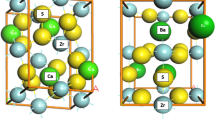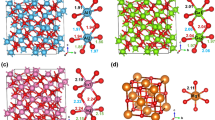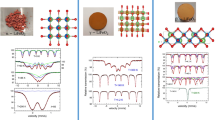Abstract
Based on density-functional theory, the electronic structures and magnetism of 3d transition metal (TM)-doped arsenene nanosheets are investigated by means of first-principles methods. The results show that Sc- and Co-doped arsenene nanosheets possess the nonmagnetic semiconducting properties, while Ti, Cr, and Cu substituting As atom can induce dilute magnetic semiconductor phase. Moreover, half-metal properties are induced in the V-, Mn-, Fe-, and Ni-doped arsenene nanosheets. In addition, results also show that Ti-, V-, Mn-, and Fe-doped arsenene nanosheets present ferromagnetic coupling, whereas Cr substitutional doping results in an antiferromagnetic coupling under their most stable configuration. These results indicate that TM doping can tune effectively the electronic and magnetic properties in the arsenene nanosheets.






Similar content being viewed by others
References
Radisavljevic B, Radenovic A, Brivio J, Giacometti V, Kis A (2011) Single-layer MoS2 transistors. Nat Nanotechnol 6:147–150
Wang Q, Kalantar-Zadeh K, Kis A, Coleman JN, Strano MS (2012) Electronics and optoelectronics of two-dimensional transition metal dichalcogenides. Nat Nanotechnol 7:699–712
Xia F, Farmer DB, Lin Y, Avouris P (2010) Graphene field-effect transistors with high on/off current ratio and large transport band gap at room temperature. Nano Lett 10:715–718
Bernardi M, Palummo M, Grossman JC (2013) Extraordinary sunlight absorption and one nanometer thick photovoltaics using two-dimensional monolayer materials. Nano Lett 13:3664–3670
Jariwala D, Sangwan VK, Lauhon LJ, Marks TJ, Hersam MC (2014) Emerging device applications for semiconducting two-dimensional transition metal dichalcogenides. ACS Nano 8:1102–1120
Bonaccorso F, Sun Z, Hasan T, Ferrari AC (2010) Graphene photonics and optoelectronics. Nat photonics 4:611–622
Li X, Yang J (2014) CrXTe3 (X = Si, Ge) nanosheets: two dimensional intrinsic ferromagnetic semiconductors. J Mater Chem C 2:7071–7076
Mak KF, He K, Shan J, Heinz TF (2012) Control of valley polarization in monolayer MoS2 by optical helicity. Nat Nanotechnol 7:494–498
Ma Y, Dai Y, Guo M, Niu C, Lu J, Huang B (2011) Electronic and magnetic properties of perfect, vacancy-doped, and nonmetal adsorbed MoSe2, MoTe2 and WS2 monolayers. Phys Chem Chem Phys 13:15546–15553
Zheng H, Zhang J, Yang S, Du X, Yan Y (2015) A first-principles study on the magnetic properties of nonmetal atom doped phosphorene monolayers. Phys Chem Chem Phys 17:16341–16350
Cai L, He J, Liu Q, Yao T, Chen L, Yan W, Hu F, Jiang Y, Zhao Y, Hu T, Sun Z, Wei S (2015) Vacancy-induced ferromagnetism of MoS2 nanosheets. J Am Chem Soc 137:2622–2627
Ataca C, Ciraci S (2010) Functionalization of BN honeycomb structure by adsorption and substitution of foreign atoms. Phys Rev B 82:165402
Srivastava P, Hembram KPSS, Mizuseki H, Lee KR, Han SS, Kim S (2015) Tuning the electronic and magnetic properties of phosphorene by vacancies and adatoms. J Phys Chem C 119:6530–6538
Bekaroglu E, Topsakal M, Cahangirov S, Ciraci S (2010) First-principles study of defects and adatoms in silicon carbide honeycomb structures. Phys Rev B 81:075433
Kamal C, Ezawa M (2015) Arsenene: two-dimensional buckled and puckered honeycomb arsenic systems. Phys Rev B 91:085423
Zhu Z, Guan J, Tománek D (2015) Strain-induced metal-semiconductor transition in monolayers and bilayers of gray arsenic: a computational study. Phys Rev B 91:161404
Wang Y, Zhang C, Ji W, Wang P (2015) Unexpected band structure and half-metal in non-metal-doped arsenene sheet. Appl Phys Express 8:065202
Wang Y, Ding Y (2015) Electronic structure and carrier mobilities of arsenene and antimonene nanoribbons: a first-principle study. Nanoscale Res Lett 10:1–10
Xia C, Xue B, Wang T, Peng Y, Jia Y (2015) Interlayer coupling effects on Schottky barrier in the arsenene-graphene van der Waals heterostructures. Appl Phys Lett 107:193107
Du J, Xia C, Wang T, Zhao X, Tan X, Wei S (2016) First-principles studies on substitutional doping by group IV and VI atoms in the two-dimensional arsenene. Appl Surf Sci 378:350–356
Yazyev OV, Helm L (2007) Defect-induced magnetism in graphene. Phys Rev B 75:125408
Yang J, Kim D, Hong J, Qian X (2010) Magnetism in boron nitride monolayer: adatom and vacancy defect. Surf Sci 604:1603–1607
Lehtinen PO, Foster AS, Ayuela A, Krasheninnikov A, Nordlund K, Nieminen RM (2003) Magnetic properties and diffusion of adatoms on a graphene sheet. Phys Rev Lett 91:017202
Cao C, Wu M, Jiang J, Cheng H (2010) Transition metal adatom and dimer adsorbed on graphene: induced magnetization and electronic structures. Phys Rev B 81:205424
Santos EJG, Sánchez-Portal D, Ayuela A (2010) Magnetism of substitutional Co impurities in graphene: realization of single π vacancies. Phys Rev B 81:125433
Yang K, Wu R, Shen L, Feng Y, Dai Y, Huang B (2010) Origin of d0 magnetism in II–VI and III–V semiconductors by substitutional doping at anion site. Phys Rev B 81:125211
Ma Y, Dai Y, Guo M, Niu C, Zhu Y, Huang B (2012) Evidence of the existence of magnetism in pristine VX2 monolayers (X = S, Se) and their strain-induced tunable magnetic properties. ACS Nano 6:1695–1701
Huang B, Yu J, Wei S (2011) Strain control of magnetism in graphene decorated by transition-metal atoms. Phys Rev B 84:075415
Cao D, Shu H, Wu T, Jiang Z, Jiao Z, Cai M, Hu W (2016) First-principles study of the origin of magnetism induced by intrinsic defects in monolayer MoS2. Appl Surf Sci 361:199–205
Cai Y, Ke Q, Zhang G, Zhang Y (2015) Energetics, charge transfer and magnetism of small molecules physisorbed on phosphorene. J Phys Chem C 119:3102–3110
Khan I, Hong J (2015) Manipulation of magnetic state in phosphorene layer by non-magnetic impurity doping. New J Phys 17:023056
Zhang S, Hu Y, Hu Z, Cai B, Zeng H (2015) Hydrogenated arsenenes as planar magnet and Dirac material. Appl Phys Lett 107:022102
Li Z, Xu W, Yu Y, Du H, Zhen K, Wang J, Luo L, Qiu H, Yang X (2016) Monolayer hexagonal arsenene with tunable electronic structures and magnetic properties via impurity doping. J Mater Chem C 4:362–370
Li Y, Xia C, Wang T, Tan X, Zhao X, Wei S (2016) Light adatoms influences on electronic structures of the two-dimensional arsenene nanosheets. Solid State Commun 230:6–10
Hashmi A, Hong J (2015) Transition metal doped phosphorene: first-principles study. J Phys Chem C 119:9198–9204
Yu W, Zhu Z, Niu C, Li C, Cho J, Jia Y (2016) Dilute magnetic semiconductor and half-Metal behaviors in 3d transition-metal doped black and blue phosphorenes: a first-principles study. Nanoscale Res Lett 11:1–9
Zhou Y, Dong J, Wang Z, Xiao H, Gao F, Zu X (2010) Electronic and magnetic properties of metal-doped BN sheet: a first-principles study. Phys Chem Chem Phys 12:7588–7592
Cheng Y, Zhu Z, Mi W, Guo Z, Schwingenschlogl U (2013) Prediction of two-dimensional diluted magnetic semiconductors: doped monolayer MoS2 systems. Phys Rev B 87:100401
Kresse G, Hafner J (1994) Ab initio molecular-dynamics simulation of the liquid-metal-amorphous-semiconductor transition in germanium. Phys Rev B 49:14251–14269
Kresse G, Furthmüller J (1996) Efficient iterative schemes for ab initio total-energy calculations using a plane-wave basis set. Phys Rev B 54:11169–11186
Perdew JP, Burke K, Ernzerhof M (1996) Generalized gradient approximation made simple. Phys Rev Lett 77:3865–3868
Blöchl PE (1994) Projector augmented-wave method. Phys Rev B 50:17953–17979
Monkhorst HJ, Pack JD (1976) Special points for Brillouin-zone integrations. Phys Rev B 13:5188–5192
Acknowledgements
This research was supported by the National Natural Science Foundation of China under Grant No. U1304518. The calculations are also supported by the High Performance Computing Center of Henan Normal University.
Author information
Authors and Affiliations
Corresponding author
Ethics declarations
Conflict of interest
The authors declare that they have no conflict of interest.
Rights and permissions
About this article
Cite this article
Du, J., Xia, C., An, Y. et al. Tunable electronic structures and magnetism in arsenene nanosheets via transition metal doping. J Mater Sci 51, 9504–9513 (2016). https://doi.org/10.1007/s10853-016-0194-z
Received:
Accepted:
Published:
Issue Date:
DOI: https://doi.org/10.1007/s10853-016-0194-z




